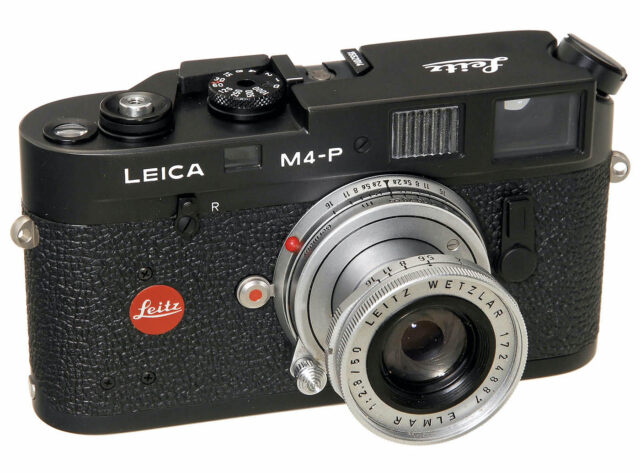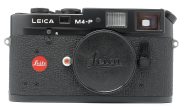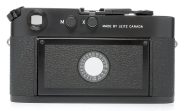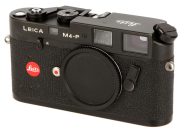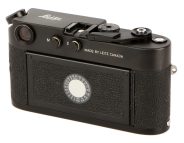Announced
Production status
System
Leica M system cameras
- Leica M (Typ 240)
- Leica M (Typ 262)
- Leica M Monochrom
- Leica M Monochrom (Typ 246)
- Leica M-A (Typ 127)
- Leica M-D (Typ 262)
- Leica M-E (Typ 220)
- Leica M-E (Typ 240)
- Leica M-P (Typ 240)
- Leica M1
- Leica M10
- Leica M10 Monochrom
- Leica M10-D
- Leica M10-P
- Leica M10-R
- Leica M11
- Leica M11 Monochrom
- Leica M11-P
- Leica M2
- Leica M3
- Leica M4
- Leica M4-2
- Leica M4-P
- Leica M5
- Leica M6
- Leica M6 (Typ 2248)
- Leica M6 Panda
- Leica M6 Titanium
- Leica M6 TTL
- Leica M6J
- Leica M7
- Leica M8
- Leica M8.2
- Leica M9
- Leica M9-P
- Leica MD
- Leica MD-2
- Leica MDa
- Leica MP
- Leica MP Original
Leica M4-P
35mm MF film rangefinder camera • Discontinued
Specification
| Format: | |
| 35mm full frame | |
Film type: | 135 cartridge-loaded film |
| Leica M [27.8mm] | |
| Shutter: | |
Type: | Focal-plane |
Model: | Mechanical |
Speeds: | 1 - 1/1000 + B |
| Exposure: | |
Exposure metering: | None |
Exposure modes: | Manual |
| Rangefinder and Viewfinder: | |
Rangefinder: | Built-in, combined with viewfinder |
Viewfinder: | Built-in, combined with rangefinder |
Finder magnification: | 0.72x |
Actual rangefinder base: | 68.5mm |
Effective rangefinder base: | 49.32mm |
Bright-line frames: | 28mm, 35mm, 50mm, 75mm, 90mm, 135mm |
Parallax compensation: | Yes |
| Physical characteristics: | |
Weight: | <No data> |
Dimensions: | <No data> |
| Accessories: | |
Body cap: | 14195 |
| 14397 |
Manufacturer description #1
As LEICA M 4-2, but with automatically superimposed field of view frames for six focal lengths: 28, 35, 50, 75, 90 and 135 mm lens.
Serial No. from 1532377.
Manufacturer description #2
The LEICA® M4-P - quick and dynamic, robust and dependable
The LEICA is the classical example of all 35mm systems cameras. It has revolutionized photography and its name has become a synonym all over the world.
The LEICA M4-P continues the series of famous rangefinder LEICA cameras. Next to the reflex LEICA-R it is a master of clearly defined tasks.
The LEICA M4-P is the camera of choice when using extremely fast lenses within the focal length range of from 21 to 135 mm. If focusing accuracy, even under poor lighting conditions, becomes the prerequisite to completely utilize the highest optical performance, the LEICA M4-P has no peer; or when instant camera readiness and hushed, silent photography is the sine qua non.
As a result of the compact combination between camera and lens and the soft, vibration-free release, even long exposures can be made by hand.
When the LEICA M4-P is combined with extreme high-speed lenses for dynamic, available light, photography for news reporting or for the instant shot.
It is no accident that the history of the LEICA and the development of modern photography and photojournalism are closely related to one another. In all areas of the world, the LEICA catches scenes difficult to repeat and documents once in a life-time events. It is always present when quick quiet and unobtrusive photography are important. This applies to reporting, to sport, to the theatre, to the church, the exhibition, the court of law or the concert hall - whenever unusual photos are being taken, the LEICA camera M4-P remains the LEICA of choice. Its secret of success is based upon the ideal combination of size and weight, quietness and quickness, as well as accuracy and dependability.
***
The LEICA M4-P-view-rangefinder: quick, simple, precise
The LEICA M4-P offers an illuminated frame-line finder which is an optical direct-image finder in its ideal form. It works with the lens and is coupled to the rangefinder measuring the distance while at the same time determining the area of the image. The viewfinder image is extremely bright and highly contrasted. Even under poor lighting conditions the photo area is determinable quickly and exactly. A bright frame borders the field of view. The remaining field is extremely important in order to observe the entire action. In sport photography this serves to determine the correct moment of exposure. The illuminated frame is coupled to the rangefinder setting in such a manner that any parallax between viewfinder and lens are automatically compensated for. The viewfinder image is easily visible even for those who wear glasses. The clearly defined measuring area shows up bright in the middle of the field and facilitates focusing. Lenses of focal lengths from 21 to 135mm are coupled automatically to the large base rangefinder of the LEICA M4-P as they are inserted into the camera housing.
The appropriate illuminated field-of-view frame for lenses from 28 to 135mm are also displayed. To preselect the correct field of view, the frame-line selector permits the photographer to determine even without lens which focal length is best suited for a particular scene. Just a fingertip pressure will switch in any other field-of-view frame-line.
Only after this control procedure has shown the optimum image outline, one inserts the appropriate lens into the camera.
The LEICA M4-P-large base rangefinder - exact focusing whether by day or by night
One glance into the rangefinder of the LEICA M4-P leaves no doubt whether exact focus has been set. The rectangular field for rangefinding in the middle of the viewfinder is clearly visible. Even under unfavorable lighting conditions, at dusk or in low artificial light, focusing is quick and certain. Even a slight distance change is shown quickly in the measuring field, regardless whether you focus with a short or a long focal length lens: the rangefinder system of the LEICA M4-P is independent of the focal length of the lens used. The large effective measuring base of 48mm guarantees sufficient accuracy even under minimum sighting conditions .
The LEICA M4-P-precision mechanics for fast, quiet photography
Film loading
The LEICA has always been a very fast camera. This is the reason why it is the camera of the professional in all areas of specialization. It starts with the quick film-loading system. Place the cartridge at left and the leader through the slot in the take-up spool. Replace the baseplate and rewind the release lever. That's all there is to do it. One has to experience it one's self in order to believe how simple it is.
Lens change
The lens change system is primarily responsible for fast camera readiness and handling comfort. LEICA lenses are changed simply and quickly by hand. Push the tab and twist the lens counter clockwise and it is free and can be removed. Insert the new lens into the bayonet in such a manner that the red dot is situated opposite the arresting knob. After a small rotation to the right the lens clicks audibly and perceptibly into position. One does not need to use a guide pin or an arresting latch aimed at a milled-out slot. LEICA lenses can be exchanged with eyes closed and you can feel the points of orientation.
The exposure release
The exposure release of the LEICA has always been synonymous with perfection. The release button is situated in exactly the right position. The wind lever for shutter advance and film transport has two positions: rest position - the lever is then located parallel to the top of the camera housing. Working position - the lever is approximately 20° off the camera housing. The film transport and shutter winding are fast and easy via a very short stroke. Everything on the LEICA M4-P is designed for simple and fast manipulation.
Low noise level camera functions
There are many photographic situations where noise-free camera operations is of extreme importance to the photographer. Loud camera noise can destroy the atmosphere or mood which the camera man wants to capture. It is the particular strength of the LEICA M4-P that its functions are very conservative with respect to noise levels; even when using the winder. Photographing in a television or radio studio with open microphones, only the very quiet rangefinder LEICA is often permitted. Whether you take your M4-P into the theatre, the concert hall, a museum or a court of law, it is always a welcomed guest. The vibration free LEICA shutter makes shooting at long exposure times out of hand practical and eliminates the often cumbersome tripod, the flood lamps or electronic flash.
Extraordinarily functional and serviceable in use
The reliability of the LEICA is legendary. It is no exception that a LEICA camera will function for forty years without trouble. Thousands of photographers all over the world use their decadeold LEICA camera for their daily photo work. Quality control, which at Leitz was always a preeminent occupation, is constantly being improved by applying the most modern technologies available.
Take a good look at the LEICA M4-P. The cast housing is made of one piece. It encloses, like armour plate, the valuable optical and mechanical parts of the camera.
The operating elements are functional both with respect to their form and their position. The quick change chromium plated bayonet mount is a masterpiece of precision mechanics. In the same elegant manner in which a lens fits into the bayonet mount, it is equally secure and precise when it is locked into place. No shake, no play, regardless of how often the lenses are exchanged . The tolerances are extraordinarily small. Even a forty year old LEICA lens when mounted with a bayonet ring, will be as precisely positioned in the camera bayonet as if it were a brand new lens.
It is precisely this accuracy and quality control that has made the LEICA into a robust camera of long life which has virtually been on the spot during the prominent events of the last fifty years. The cold of the Antarctic, the heat of the Tropics or the rain forest - the LEICA can be depended upon. In the future it will like-wise be in the center of events.
Special editions (2)
- Leica M4-P "Everest 1982" (200 units) - 1982
- Leica M4-P "Leica 1913-1983" (2500 units) - 1983
Similar cameras (13)
35mm full frame • Manual focus • Film • Rangefinder • Leica M mount
| Model | Shutter | Metering | Modes | Year |
|---|---|---|---|---|
| Cosina Voigtlander BESSA-R2 | M, 1/2000 | TTL • WA | M | 2002 ● |
| Cosina Voigtlander BESSA-R2A | E, 1/2000 | TTL • WA | AM | 2004 ● |
| Cosina Voigtlander BESSA-R2M | M, 1/2000 | TTL • WA | M | 2006 ● |
| Cosina Voigtlander BESSA-R3A | E, 1/2000 | TTL • WA | AM | 2004 ● |
| Cosina Voigtlander BESSA-R3M | M, 1/2000 | TTL • WA | M | 2006 ● |
| Cosina Voigtlander BESSA-R4A | E, 1/2000 | TTL • WA | AM | 2006 ● |
| Cosina Voigtlander BESSA-R4M | M, 1/2000 | TTL • WA | M | 2006 ● |
| Cosina Voigtlander BESSA-T | M, 1/2000 | TTL • WA | M | 2001 ● |
| Konica HEXAR RF | E, 1/4000 | TTL • WA | AM | 1999 ● |
| Leica CL aka LEITZ minolta CL |
M, 1/1000 | TTL • WA | M | 1973 ● |
| Minolta CLE | E, 1/1000 | TTL • WA | AM | 1980 ● |
| Rollei 35 RF | M, 1/2000 | TTL • WA | M | 2002 ● |
| Zeiss Ikon | E, 1/2000 | TTL • WA | AM | 2004 ● |
